26 Most Famous Landmarks in Portugal You Need to Visit
The Best Landmarks in Portugal Recommended by Professional Travel Writers!
The most western European country, the birthplace of the legendary soccer player Christiano Ronaldo and home of the incredible, mouthwatering Pastéis de Nata.
Yes, Portugal can claim many titles for itself.
Nevertheless, the country on the Iberian peninsula does often not get as much attention as its neighbor Spain, although it actually deserves it.
Portugal’s history dates back thousands of years and that’s why it has a rich and colorful past. Parts of these earlier centuries can still be admired today in the form of medieval villages, towns, and different architecture.
This comprehensive list includes both natural and man-made landmarks in Portugal you shouldn’t miss adding to your bucket list. Each and every one of them was personally visited and recommended by a travel blogger.
(This post contains affiliate links, which means I receive a certain percentage of a sale if you purchase after clicking.)
Famous Landmarks in Lisbon
1. Jerónimos Monastery
Recommended by Or of My Path in the World
Situated in the district of Belem behind the Monument to the Discoveries and the Jardim da Praça do Império, the Jerónimos Monastery is among the most famous UNESCO World Heritage Sites in Europe and thus must be on your Lisbon itinerary.
Dating back to the 16th-17th centuries and commissioned by King Manuel I, the monastery was the seat of the Hieronymite monks (from the Order of Saint Jerome). However, its historical significance is mostly connected to Portugal’s Age of Discovery.

First of all, the monastery replaced another church commissioned by King Manuel I. I
t is believed that it was where the explorer Vasco da Gama prayed a night before his expedition to India at the end of the 15th century.
In addition, one of the roles of the monastery’s monks was to provide spiritual guidance for other navigators in their search for new lands.
The monastery depicts a remarkable example of Manueline-style (Portuguese late Gothic) architecture. To see even more of it, buy an entry ticket for €10 to explore its exteriors, which can easily take a couple of hours of your time.
The landmark is especially known for its two-story cloister, but it’s full of other beautiful corners.
TIP: If you want to enjoy free access to Lisbon’s best landmarks you can buy the Lisboa Card for 24, 48 or 72 hours.
2. Belém Tower
Recommended by Cath of Passports and Adventures
Belém Tower is an iconic landmark in Portugal. Located in Lisbon, and officially called the Tower of Saint Vincent, it dates from the early 16th century.
It is a fortified tower that served as the embarkation and disembarkation point for Portuguese explorers and was considered the gateway to the city.
Belém Tower is also one of the most photographed landmarks in Lisbon thanks to its location and architecture.
It is open all year round from 10:00 am and closes at 5:30 pm between October and April and 6:30 pm from May to September. Entrance fees are only €6 per person and can be bought on-site.

Belém Tower is easily reached from other parts of Lisbon and is a great place to visit in Lisbon with kids. Visitors can expect to spend about an hour here.
There is a large green space in front of the tower in which you can enjoy ice cream on hot summer days. Moreover, you can combine the visit with a trip to the Jerónimos Monastery nearby.
Tours you might find interesting:
3. Santa Justa Lift
Recommended by Erin of Pina Travels
The Santa Justa Lift, which is also sometimes called Carmo Lift, is an outdoor, Gothic-style iron elevator in the historic center of Lisbon.
Santa Justa Lift was completed in 1902, built by Raoul Mesnier du Ponsard, a Portuguese engineer. It’s one of four mid-twentieth-century lifts that are still actively used in Lisbon but is the only one that runs fully vertical.

Lisbon is a very hilly city, in fact, it is known as the city of the seven hills. The Santa Justa Lift is one way that locals and visitors can avoid having to climb up at least some of the steep hills on foot.
Santa Justa Lift provides an easy way to get from Baixa’s lower roads to the higher roads of Largo do Carmo. The trip up carries riders seven stories (45 meters) high.
Riding up this historic lift is a must-do in Lisbon, and not just because it helps avoid climbing hills.
When riding the Santa Justa Lift, you get a close-up view of its iron Gothic design. And, at the top end of the ride, you’ll be treated to beautiful aerial views of the city.
A return ride costs €5.15 and the lift operates daily from early morning to late evening.
TIP: If you want to enjoy free access to Lisbon’s best landmarks you can buy the Lisboa Card for 24, 48 or 72 hours.
4. São Jorge Castle
Recommended by Kenny of Knycx Journeying
Alfama is Lisbon’s old town located on a slope between the São Jorge Castle and the Tagus riverfront.
For Lisbon first-timers, it’s imperative to walk through the maze-like Alfama as it’s filled with terracotta-roofed houses, vintage stores, cafés, and local markets.
At the top of the hill, the São Jorge Castle is a prime location to take a breathtaking view of the entire capital city.

The castle was established in the 5th century by Visigoths because of its geographic significance.
Several restructurings were done when the Moorish took over, and eventually become a royal residence of the Portuguese in the 15th century – important events like the coronations took place several times at this site.
For centuries, the castle served as an important fortification for defense, and now, it’s one of the most visited landmarks in Portugal.
Take a walk in the castle and appreciate the architecture and Moorish design. The archaeological site of the castle still has traces of the three cultures that occupied here, and ruins that date back to the 8th century BC.
If you want to learn everything about the castle’s history, the best is to buy a skip-the-line ticket for a guided tour online.
Tours you might find interesting:
5. Sanctuary of Christ the King
Recommended by Martha of May Cause Wanderlust
The tall statue just across the estuary from Lisbon might look familiar to you.
It’s said to be inspired by the Christ the Redeemer statue in Rio de Janeiro, and it certainly bears a strong resemblance to it: the statue of Christ with his arms outstretched stands on top of a tall column, seemingly protecting Lisbon from on high.
The monument was inaugurated in 1959 and was built to express gratitude for Portugal having been spared the destruction that happened elsewhere in Europe during World War II.

Visiting the Sanctuary is one of the many things to do in Lisbon. It is located in Almada and you can get there by ferry and bus, or bus from central Lisbon, but these routes are fairly slow, so a taxi would be faster.
When you’re there, you can visit the Catholic chapel at the base of the structure, and you can go up in a lift (and some stairs) to get a view from the observation deck 84 meters up, which is open from 10:00 am to 6:00 pm every day (last entry at 5:40 pm) and costs €6 for adults.
However, the view from the ground level of the monument is also wonderful, because it is on a high cliff overlooking the water and Lisbon, which both glisten in the sunlight.
Popular Landmarks in Porto
6. Porto Cathedral
Recommended by Katy of A Rambling Unicorn
The Porto Cathedral (Sé do Porto) is an impressive historical landmark in Porto’s city center.
Situated on a hill overlooking the Douro River, the building is a distinctive part of the city’s skyline and can be seen from miles away.
Construction on the cathedral began in the 12th century. Since that time, the building has undergone extensive renovations and now comprises an interesting mix of Romanesque, Gothic and Baroque architectural styles.
Today the cathedral is the biggest church in Porto and an important stop on the Portuguese Camino, a spiritual pilgrimage route.

One of the highlights of the cathedral is the cloister. This area dates to the 14th century and includes a beautiful collection of azulejo (traditional Portuguese and Spanish ceramic tiles).
The ornate silver altarpiece in the Chapel of the Holy Sacrament is another key feature. Be sure to climb the tower for sweeping views of the entire city.
The cathedral is open every day from 9:00 am to 5:30 pm from November to March. In the summer, the building is open until 6:30 pm. The cloister closes every day from 12:30 to 2:30 pm.
The cost to tour the cathedral is €3 (children 10 and under are free).
7. São Bento Railway Station
Recommended by Jenifer of The Evolista
Sitting in the shadow of Portugal’s Douro River, the São Bento Train Station is a breathtaking work of architecture and one of the most famous landmarks in Portugal. This station is the perfect starting point for a 2 day Porto itinerary.
With its intricate tilework and beautiful Beaux-Arts architecture, it’s hard to believe that this is an important transportation hub.
From the outside, the building is handsome but it’s nothing compared to the artistic treasure that you’ll find inside.
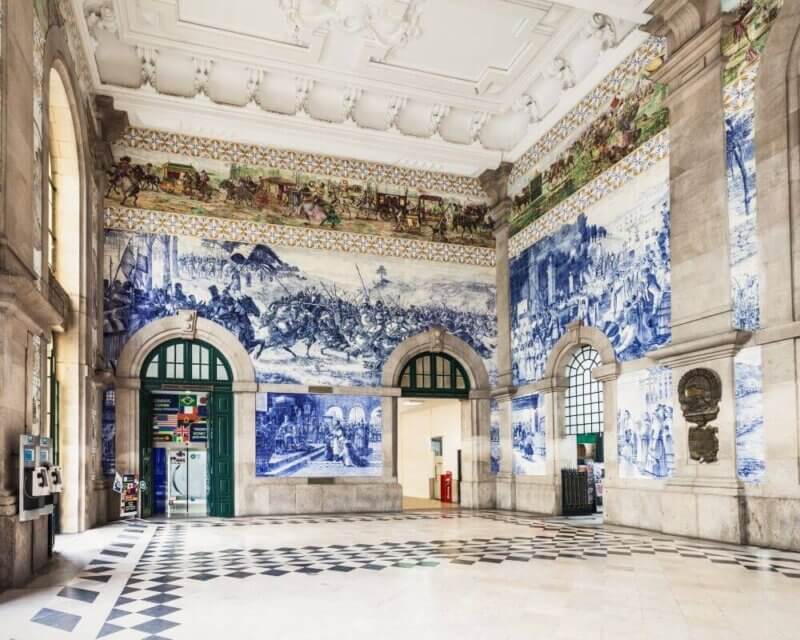
Known for the 20,000 colorful azulejo tiles that line its walls, created by Jorge Colaço, each tile tells a story, and together they create an intricate masterpiece of Portuguese history and its people.
São Bento station is located right in the heart of downtown Porto, making it easy to get around once you arrive in Porto.
The station is open daily from 9:00 am to 6:00 pm. If you’re visiting Porto, be sure to stop by the São Bento Train Station and take in its beauty!
Tours you might find interesting:
8. Dom Luís I Bridge
Recommended by Maggie of Pink Caddy Travelogue
As the kids say – did you even go to Porto if you didn’t see the Dom Luis I bridge?
No, because it’s impossible to miss.
Porto’s iconic double-decker bridge was built between 1881 and 1886 to connect the busy downtown Ribeira district to the Port wine houses in Vila Nova de Gaia. It was named after the then King of Portugal, Luís I.
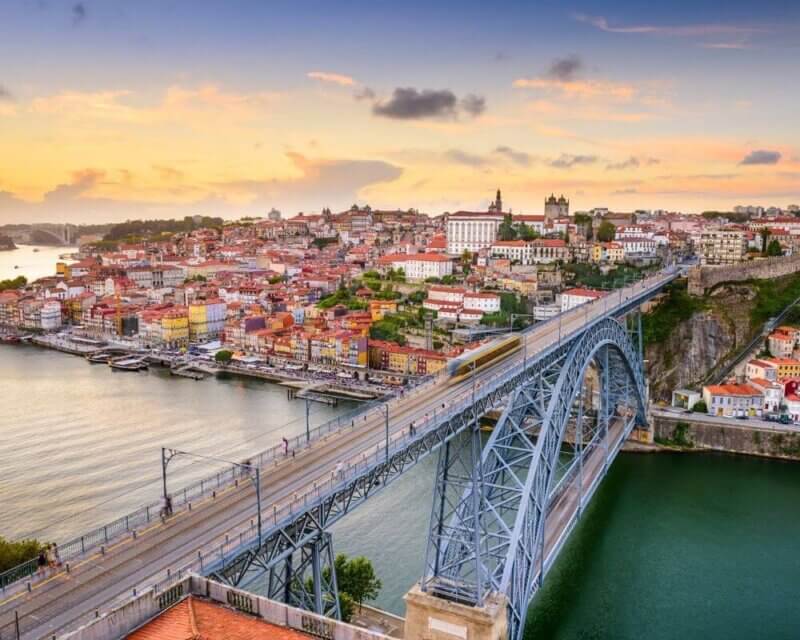
If the massive ironworks structure with its great arch support is reminiscent of Paris’ Eiffel Tower, there’s a reason for that.
Gustave Eiffel designed another one of Porto’s bridges (D. Maria Pia bridge, named for King Luís’ wife), and a few years later, Eiffel’s partner Théophile Seyrig, oversaw the construction of the Dom Luís I bridge.
The bridge has two levels – the lower deck supports vehicle traffic, and the Porto metro uses the top. But pedestrians can cross on either level.
Walking across the top is a must-do when spending one day in Porto. But at 190 ft (60 m) above the waters of the Douro River, it’s not for those afraid of heights!
Famous Landmarks in Sintra
9. Quinta da Regaleira
Recommended by me
Another one of the most famous landmarks in Portugal can be found near the historic center of Sintra.
Surrounded by lush green vegetation, Quinta da Regaleira is a place full of magic and mystery. This grand, gothic-style mansion was built by Antonio Carvalho Monteiro, an eccentric entomologist who loved everything esoteric.
Although the grand house with more than five floors is already an attraction, the most awesome thing about the entire place is the enchanting gardens surrounding the main building.

It’s full of hidden tunnels and concealed symbolism and includes an Initiation well that was built for secret ceremonial purposes.
Quinta da Regaleira is open all year long from 9:30 am – 8:00 pm (summer) and 9:30 am – 6:00 pm (winter).
The entrance fee for the grand house and the gardens is €6 for adults and €4 for children. Usually, a visit lasts around 1.5 – 2 hours to see everything.
Tours you might find interesting:
10. Castle of the Moors
Recommended by Greta of Greta’s Travels
If you’re looking for the most beautiful and famous landmarks in Portugal, you have to add Castelo dos Mouros to your bucket list. Also known as the Castle of the Moors, this hilltop medieval castle offers unparalleled views over Sintra.
Castelo dos Mouros is located a short 15-minute walk from Palacio da Pena, and yet most travelers overlook it when planning their day trip to Sintra.
Make sure you don’t make the same mistake!

Moors built the castle in the 8th and 9th centuries, during the period of Muslim Iberia, and it was an important strategic point during medieval wars.
The entrance is €7.60 if you purchase it online beforehand, or 5% more if bought at the ticket machine at the entrance. The castle is open every day from 10:00 am to 6:00 pm.
You can easily spend an hour walking on the castle walls and enjoying the views, as well as strolling through the spacious courtyard and learning about the history of the castle.
From the castle, you can see the town of Sintra, the surrounding countryside and all the way to the sea on clear days.
11. Pena Palace
Recommended by Emma of Travel on a Time Budget
The Pena Palace is a magical place to visit.
A former royal summer residence, it’s located on top of a hill in Sintra, just 30 km away from the capital, Lisbon, and an easy day trip by public transport.
The palace itself is both unique and stunning – and certainly memorable. The mix of different architectural styles, as well as the palace’s colors – bright reds, yellows and oranges – lend it an almost whimsical, fairy-tale appeal.
This might explain why up to 800,000 people visit a year.
There are plenty of things to see inside the palace. This includes the chance to wander through rooms where kings and queens ate, slept, played, and worked.

However, a visit here is not just about the palace. It sits high on a hill with sweeping views across the area and within 200 hectares of parkland and forest.
Here you’ll find lakes, gardens and temples, as well as an alpine chalet that was used as a summer retreat in the 19th century.
The size of the park means that you could easily visit for a full day, especially in summer when the weather is warmer.
Opening times for the palace are 9:30 am to 6:30 pm for the palace. The park opens and closes half an hour earlier and later.
Keep in mind that it can get really crowded so make sure to buy entrance tickets online to avoid queuing.
Tours you might find interesting:
Natural Landmarks in Portugal
12. Algar Seco Caves
Recommended by Maartje & Sebastiaan of The Orange Backpack
Whenever visiting the Algarve coast in southern Portugal, the Algar Seco caves should definitely be on top of your wish list.
This small coastal strip at the edge of the charming beach town of Carvoeiro will show you the orange rock cliffs of the Algarve at their best.
Just south of Carvoeiro, you’ll find the Carvoeiro Boardwalk leading along the cliffs.
It is only 600 meters, so you’ll probably assume it isn’t worth the trouble of your time unless you learn about the Algar Seco caves you can visit here as well.
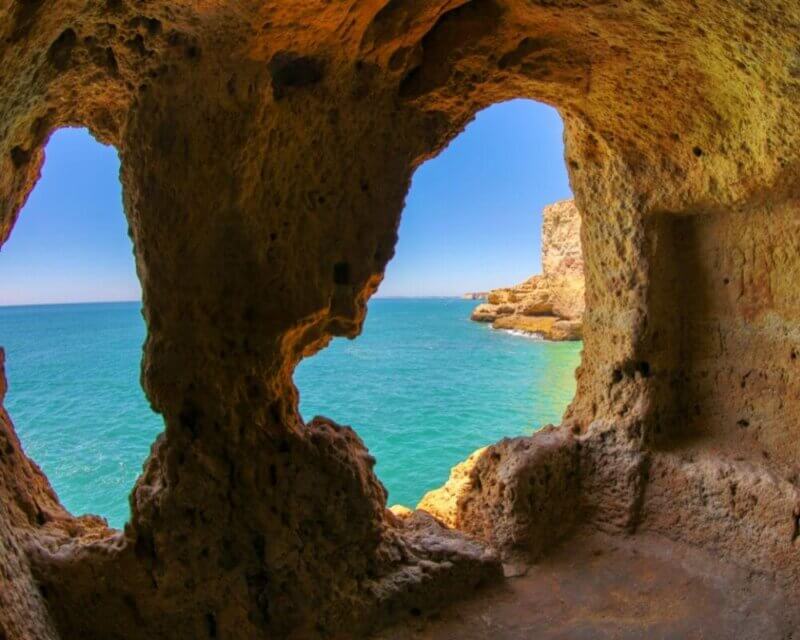
The path has two spots where you can leave the boardwalk and climb down some stairs. That’s where you’ll find two of the most exciting places along the Algarve coast!
You’ll get to climb down the rocks, pass arches, walk paths carved out into the rocks, enjoy stunning views of the Portuguese coast and enjoy the famous rock cliffs of southern Portugal from up close.
One of the best things is the natural pool where you can take a dip.
Visiting the boardwalk and caves is free. There are no opening times, though you shouldn’t want to visit the rocks after sunset, but only during the daytime.
13. Benagil Cave
Recommended by Becki of Meet Me In Departures
The Benagil Cave is probably the most visited and photographed cave on the southern coast of Portugal, and certainly one of the must-see landmarks in Portugal, especially along the Algarve coast.
Although this coastal region is blessed with numerous caves, the Benagil Cave is the most popular of them all. The open-top cave can only be reached by the water, although you can peer down from the open crevice from the top.
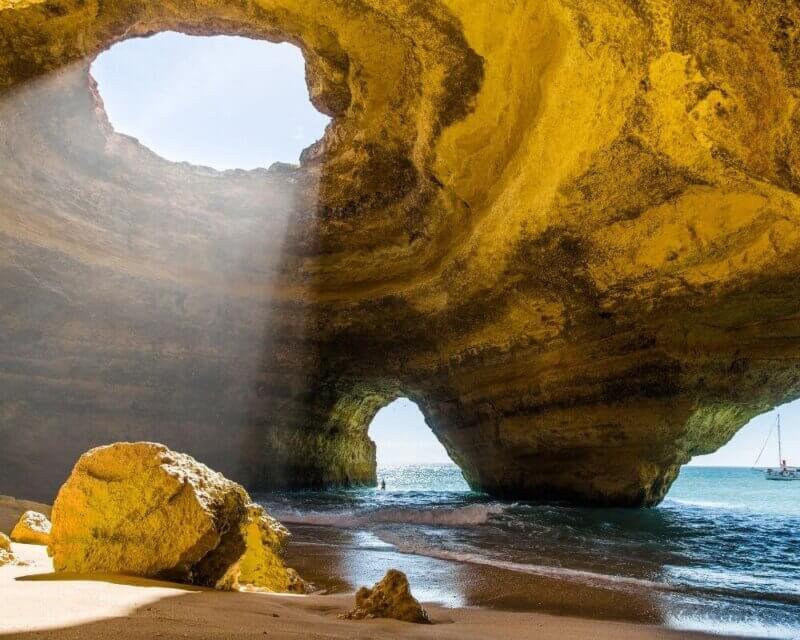
To access the cave, you have to go by boat, or if you’re an adventure and adrenalin addict, then opt for kayak or paddleboard. There are numerous tours offering trips to see the cave, and it draws tourists from far and wide to see it.
The nearest village to the cave is of the same name; Benagil. This is where you’ll find numerous kayak companies offering tours that run for two or three hours.
Depending on the time of year, kayaking at Benagil Cave allows you to walk on the small beach inside the cave.
If you don’t want to kayak to the caves, then there are plenty of boat tour operators from beach towns along the coast. However, keep in mind that if you’re going by boat, you probably won’t disembark in the cave, you just sail into it.
Tours you might find interesting:
14. Ponta da Piedade
Recommended by Nadine of Le Long Weekend
Just a short drive from Lagos, in Portugal’s Algarve region, you’ll find the spectacular Ponta da Piedade.
It’s a coastal headland that has been eroded over the years to reveal caves, bridges, natural arches, and sea grottos, and it’s an absolutely fascinating area to discover.
To do so, you can either walk or drive from Lagos, and wander along the cliffs to view the pillars from above, or you can take a boat tour to discover it from the sea.
Boat tours are available from within the Ponta da Piedade itself, or from Lagos, and both options cost around €20 per person.

The boats will whip you through the caves and into hidden grottos, pointing out the various animal-shaped rocks along the way.
After your tour, take time to walk the Ponta de Piedade boardwalk from the lighthouse to the Praia do Canavial lookout point.
Moreover, take a visit to the Insta-famous Praia do Camilo beach, one of the best beaches in Portugal, for a dip in the sea and lunch at the stunning Camilo restaurant.
Combining a boat tour with a short walk and a visit to a nearby beach will take you half a day, but you could easily spend longer if you prefer to stay awhile on the sand.
15. Pico do Arieiro
Recommended by Marjut of The Smooth Escape
Pico do Arieiro is a mountain peak on the island of Madeira, which lies about 1000 kilometers southwest of mainland Portugal.
With a height of 1,818 meters, it’s the island’s third-highest peak and offers phenomenal views of jagged mountains, lush valleys and the Atlantic Ocean.
It is one of the most famous attractions on the island and should be a part of every Madeira itinerary.
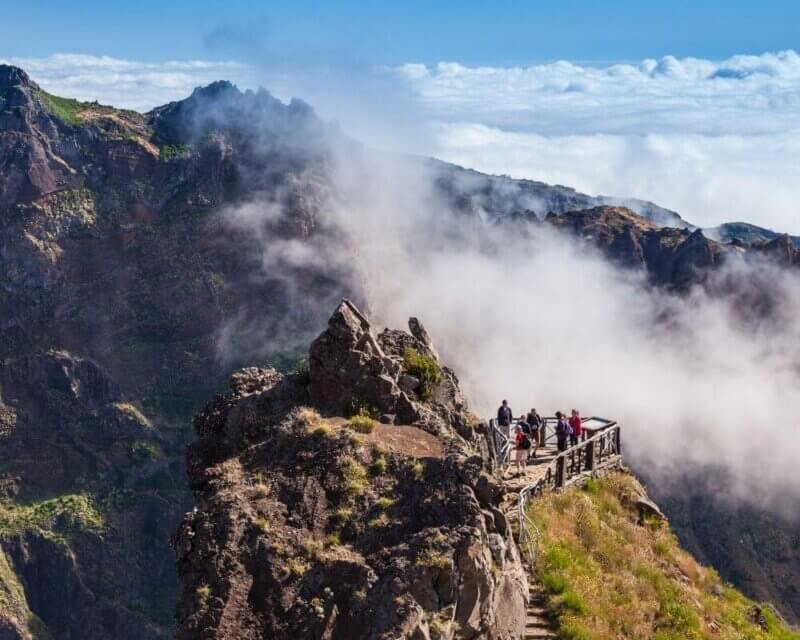
The best time to visit Pico do Arieiro is at the break of dawn. Every morning people gather there to witness the most breathtaking sunrise above the clouds and watch the sky turn pink.
You can easily spend an hour here enjoying the views from the various lookout points.
Pico do Arieiro is also the starting point of the hiking trail to Pico Ruivo, the highest peak of Madeira. It’s one of the best hikes in Madeira but relatively challenging with 12 kilometers featuring steep ascents, tunnels and stunning mountain scenery.
Besides the spectacular views, the reason why Pico do Arieiro is so popular is that it’s easily accessible by car. It takes just 40 minutes to drive there from Madeira’s capital city Funchal.
There’s no entrance fee to visit Pico do Arieiro and it’s always open.
Tours you might find interesting:
16. The Torre, Serra da Estrela Natural Park
Recommended by Cath of Wales with Kids
Another one of the best landmarks in Portugal to visit, particularly during summer, is the Torre in the Serra da Estrela Natural Park.
Standing at the highest point in continental Portugal, it is not so much a distinctive mountain summit, but the highest point in the Serra da Estrela Mountain range.
The point is marked by a trig comprising a cross on a stone monument. The trig stands in a roundabout at the Torre.
Also located at the Torre are two other towers with dome-shaped roofs that were former radar towers for the Portuguese Air Force, the largest of which now belongs to the GNR (national police force).
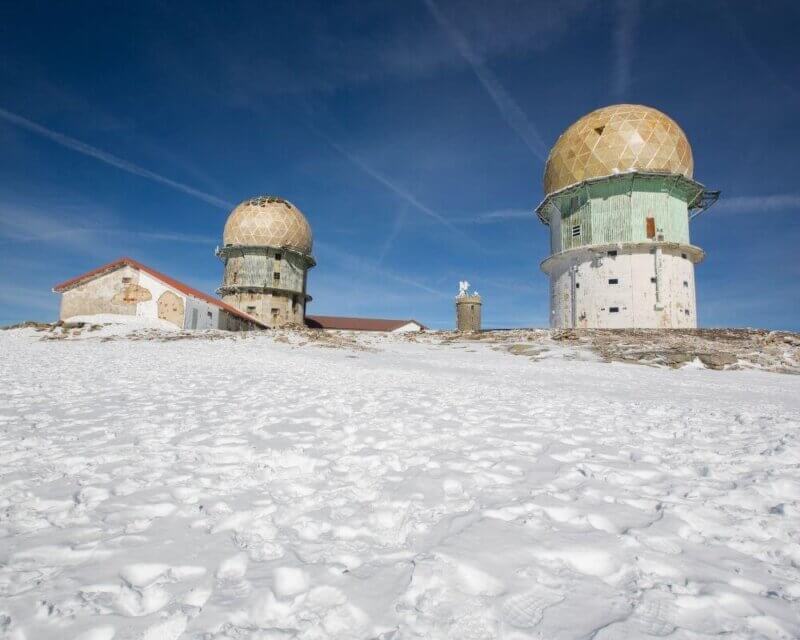
The Torre is accessible all year round except when there has been heavy snowfall. Yes, this area of Portugal gets snow during winter and is the only ski resort in the country. It is free to visit the Torre, you just need to make your way up the mountain by car.
There is a cable car that takes you down the valley and a restaurant from which you can enjoy views across the valleys and mountain ranges.
There are also shops selling local produce and crafts including Serra da Estrela cheese and ham. Make sure to purchase some before you leave the mountaintop.
This area of Portugal is amazing to visit, but be warned, it can get chilly at the top, even in summer, so bring a few layers just in case.
17. Marinha Beach
Recommended by Linn of Amused by Algarve
One of the most breathtaking landmarks in Portugal is without a doubt Marinha beach in the Algarve.
Several times nominated the most beautiful beach in the world with its jaw-dropping setting below dramatic cliffs looking out on large rock formations towering from the glittering Atlantic Ocean.
Access to the beach is free. You can either take bus no. 77 from Lagos or drive there and park at the large parking area above the beach.
There is a fair set of steps to get down to the beach, so you might want to get a cold drink at one of the stalls before you walk down.

Once at the beach, there are no sunbeds or umbrellas for rent, but you can get food and drinks at the one restaurant.
They also have free toilets you can use throughout the day. Other than sunbathing, you can walk up and down the beach to see the rock formations up close or rent a paddleboard or kayak.
There is also a tiny hidden beach through a tunnel in the left cliff wall worth visiting.
Tours you might find interesting:
18. Cabo de São Vicente
Recommended by Alya & Campbell of The Algarve Family
Cabo de São Vicente (Cape St.Vincent) is a picturesque cape situated 6 km west of the town of Sagres, in the Algarve province, southern Portugal.
The cape is known as the southwesternmost point of continental Europe.
The scenery around the cape is breathtaking; rugged cliffs, hidden beaches, dramatic drops, and the blue waters of the Atlantic Ocean. The Lighthouse of Cabo de São Vicente is nested on the very edge of the cape.
It’s a working lighthouse that can be visited on Wednesdays between 2:00 pm and 4:00 pm, the museum is open Tuesday to Sunday from 10:00 am to 5:00 pm.
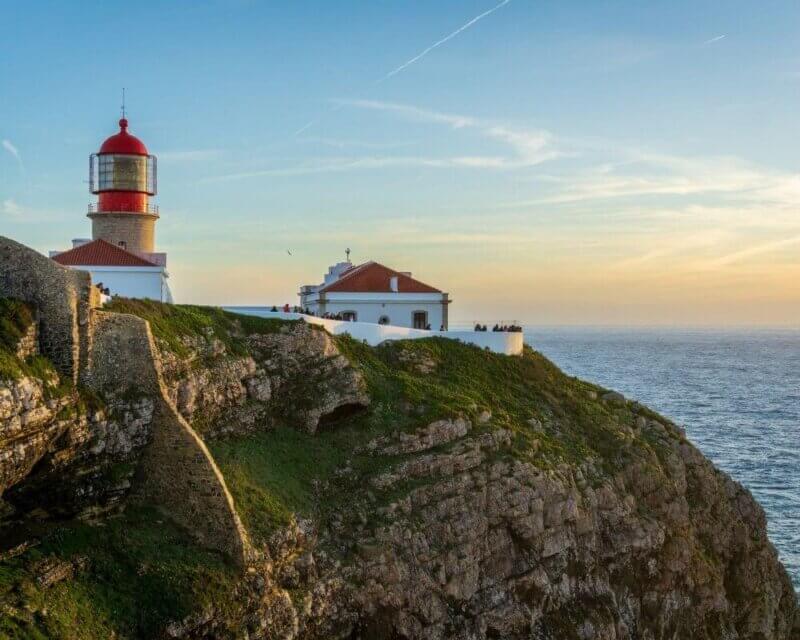
You can spend a couple of hours visiting the lighthouse and exploring the coastline of the cape.
In the hot and busy summer months, early mornings and evenings are the best time to come to Cabo de São Vicente.
Cabo de São Vicente is one of the most romantic places for watching the sunset in Portugal. Watching the sun slowly disappear in the ocean and listening to the waves breaking against the cliffs is an unforgettable experience.
19. Covão dos Conchos
Recommended by Izzy & Phil of The Gap Decaders
The fascinating Covao dos Conchos, called ‘the eye’ by locals, is in the Serra da Estrela natural park in Portugal.
This incredible man-made lake hole is actually a bell mouth spillway and well worth the hike if you’re road-tripping Portugal.
The whole area around Lagoa Comprida, the start of the hike, and Cavao dos Conchos is a designated GeoPark formed millions of years ago by glaciers, which have left fantastic irregular boulder fields, huge exposed slabs of rock and deep ravines to explore.
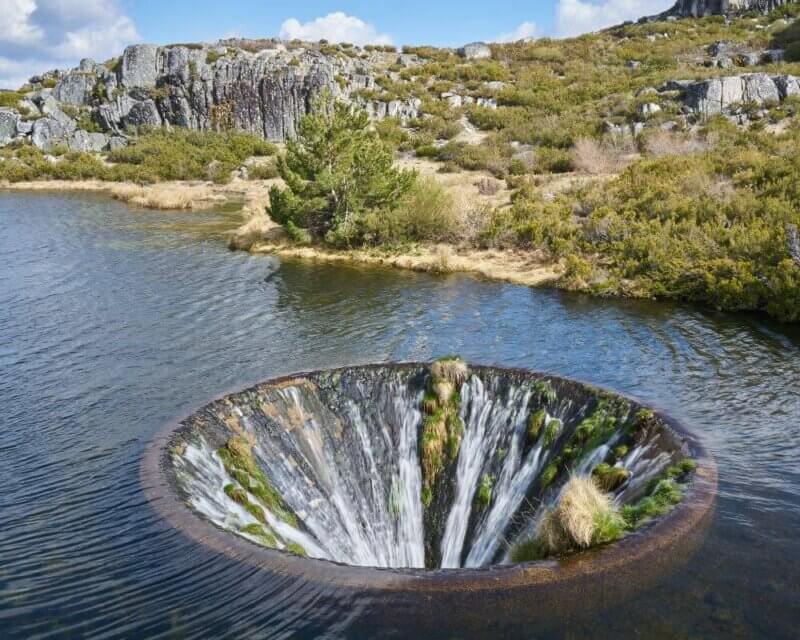
Covao dos Conches diverts water from the surrounding mountains and Ribeira das Naves to Lagoa Comprida. Moreover, it’s part of the hydroelectric dam system of Serra da Estrela.
The engineered structure has a height of 4.6 m and a circumference of 48 m. Inside the eye is a tunnel that collects the water as it rushes in, which is a whopping 1519m long, before taking it to Lagoa Comprida.
The path is well signed at the start and easy to follow. The hike itself is a there-and-back easy walk, with just 173 m of elevation over 8.2 km.
Once at Covao dos Conchos, you can spend time by the lake enjoying the wildlife and even swim in the summer months, for a really up-close look at the hole.
Other Landmarks in Portugal
20. Cathedral of Faro
Recommended by Paulina of Paulina on the Road
Faro Cathedral is undoubtedly one of the best cathedrals to visit in Portugal. Situated in the heart of Cidade Velha in Largo de Se, Faro Cathedral holds a special place whenever there’s a talk about landmarks in Portugal.
The cathedral has a lot of history to tell. It was built on the location of a Roman forum that turned into a mosque. The mosque was later turned into a church in 1249.

Since its development, Faro Cathedral has gone through various destruction and damage as a result of the disaster and attacks.
The building that exists at present is a symbol of its architectural influences and historical incidents. That is what makes it special.
The Portuguese skies, Belltower, and Gothic portal entry surrounding the cathedral offer iconic views. A visit is definitely one of the best things to do in Faro.
Although the cathedral does not appear as big from the outside, it is unexpected from the inside. Make sure to spend at least two hours exploring all of it.
You can get entry into the Cathedral at just €3.5. It is open Monday to Saturday from 10:00 am to 5:30 pm.
You can either take a bus to Lardo S. Francisco or you can find out where to stay in Algarve for a longer vacation.
21. Monsanto
Recommended by Carina of bucketlist2life
Monsanto is the perfect addition to every Portugal road trip.
The small village with less than a thousand inhabitants is located in eastern Portugal close to the Spanish border and around three hours from Porto or Lisbon.
The village belongs to the 12 historical villages – the Aldeias Históricas. It is also known as “the most Portuguese village in Portugal”.
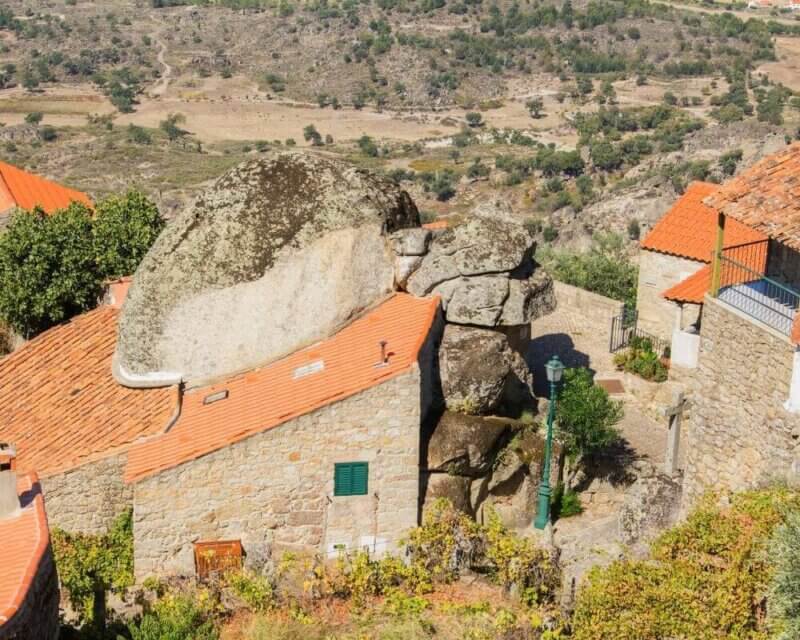
The village’s most iconic features are the granite boulders which are so prevalent that they were even included in the construction of roads and buildings.
The town is crowned by a medieval castle that offers amazing views over the whole area – of course, it’s also littered with huge granite rocks.
Monsanto is a functioning village with shops and restaurants. Additionally, you can find some cute accommodations and it will be definitely worth spending one night here.
Don’t miss this picturesque jewel!
22. Arouca Bridge
Recommended by Raluca of Travel With A Spin
516 Arouca Pedestrian suspended bridge was opened in 2021 and is the longest of its type in Europe. Some say even in the world. But the place is disputed between it and another bridge in Nepal.
The bridge is in Arouca Geopark, about an hour and a half south of Porto.
As it’s in a protected area, there are also other trails and traditional villages to make it worth a full-day trip or even a weekend in the area.

A popular day trip from Porto also includes Paiva Pathways. This is a wooden 8.5 trail zig-zagging along the river which starts right next to the bridge.
In fact, so many people do it together that the €12 fee for the bridge includes the entrance on the path.
The opening times vary depending on the season, but Arouca Bridge is generally open from sunrise to sunset.
Crossing the bridge both ways takes around half an hour including time to take in the wonderful landscapes of the canyon and Aguieiras Waterfall. In order to also do the trail, you’ll need around three hours each way.
23. Coimbra University
Recommended by Soumya of Stories by Soumya
The University of Coimbra, a beautiful historical landmark, is a must-have on every Portugal itinerary.
Established in 1290 CE, Coimbra University is one of the oldest universities in the world. Apart from being a preferred institute for higher education in Portugal, it is home to stunning architecture and fascinating buildings from the 12th and 13th centuries.
Highlights include the beautiful Joanine Library (believed to have inspired the Harry Potter Library), the Royal Palace of Alcacova which houses the university today, and a 12th-century Cathedral of Santa Cruz.
Don’t miss the Science Museum and the Gallery of Natural History which are treasure troves waiting to be dug into.

Visits are priced differently depending on what you want to see. Check out the admission fees on the official website before planning your trip.
Coimbra University is open to tourists from 9:00 am – 5:00 pm every day.
You would want to spend at least 2-3 hours here to see the best that the university has to offer. Get a good pair of shoes because there’s a lot of walking and climbing involved.
The University of Coimbra is listed on the UNESCO World Heritage list and makes for the perfect heritage destination in Central Portugal.
Tours you might find interesting:
24. Batalha Monastery
Recommended by Jorge & Cláudia of TravelDrafts
Located in the Center of Portugal, relatively close to Leiria, the Batalha Monastery is one of the most famous landmarks in Portugal.
Batalha means Battle in Portuguese, and the monastery was built to commemorate the decisive victory of the Portuguese against Castille.
Built through almost two centuries (1385-1580) in an impressive Manueline style, Batalha Monastery has been a European UNESCO heritage site since 1983, and it was considered one of the seven wonders of Portugal in a contest in 2007.

The monastery is huge, so it should take at least two hours to visit it.
Batalha Monastery opens every day from 9:00 am to 6:00 pm (6:30 pm between the 1st of April and the 15th of October), with the last entrance 30 minutes before closure.
The ticket costs €6, but there are discounts for children, groups, and the elderly.
The visit will include the main nave, the cloisters, the chapterhouse, and the unique unfinished Chapels. The royal cloisters and the unfinished chapels are some of the most intricate works in Portugal and a reason alone to visit Batalha Monastery.
25. Castle of Guimarães
Recommended by Jorge & Cláudia of Portugal Things
Located in the North of Portugal in Guimarães is one of the most iconic landmarks in Portugal, the Castle of Guimarães.
This famous landmark is one of the most important locations in Portugal’s history because it is the birthplace of Portugal.
The Castle of Guimarães was built in the 10th century to defend the city from attacks from the Moors and Norsemen. In the 11th century, D. Afonso Henriques (Portugal’s first King) was born and lived in this castle.
It was also where the nobleman and Afonso Henriques plotted the idea of making Portucale independent from the Kingdom of Leon (Spain).
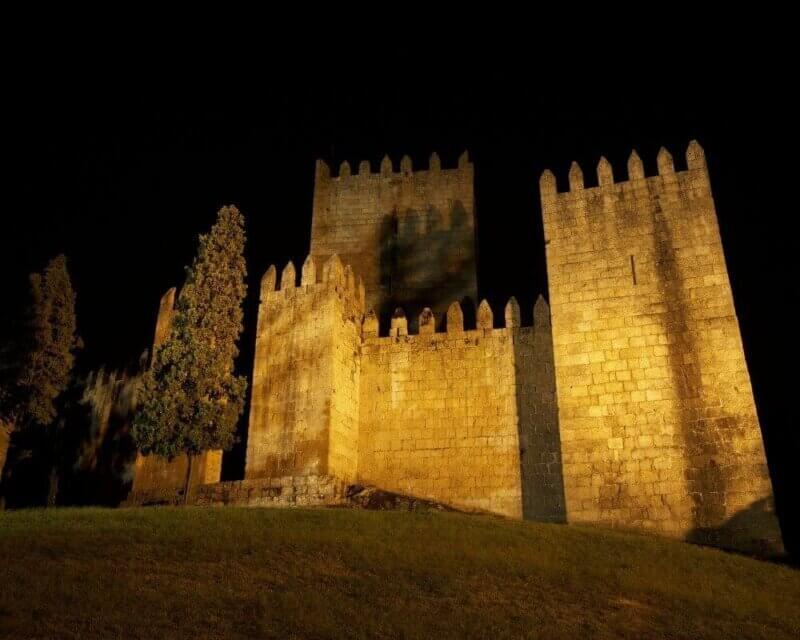
Near the castle, Afonso Henriques won the battle of S. Mamede against his mother, ensuring the independence of Portugal. You can find, in front of the castle, a statue in homage to Afonso Henriques, the first Portuguese king.
Besides its historical importance, the castle is a fun visit, as it is well preserved and a good place to learn about Portugal, climb the fortifications and enjoy the views of the city of Guimarães.
The entrance fee to visit the castle is €2. It is recommended to spend about one hour exploring the castle.
In front of the castle, there’s also the Palace of the Dukes of Bragança which is also well worth visiting.
Tours you might find interesting:
26. Chapel of Bones
Recommended by De Wet of Museum of Wander
The Capela dos Ossos, or Chapel of Bones, is one of the best most popular places to visit in Evora and one of the rather extraordinary landmarks in Portugal.
The small chapel is more than just a catchy name: the entire interior of the chapel is decorated with human bones and skulls.
Built during the 17th century, the Chapel of Bones is still a vivid reminder to visitors today about how temporary and fragile life is.
As you enter the chapel, look out for the phrase above the doorway. It translates as These bones that lay here wait to welcome yours.
The skulls and bones come from an estimated 5000 bodies exhumed when the cemeteries in Evora got overcrowded.

It takes about 30 minutes to see the small but macabre chapel. The chapel is part of the larger Church São Francisco, which is included in the admission fee, so also plan to spend at least another 30 minutes seeing the church.
The Chapel of Bones is located inside the citywall of Evora on Rua da República. It’s open between 9:00 am and 5:00 pm, and the entrance fee is €5 for adults.
Check out:
– 24 Amazing Landmarks in Spain
– 27 Famous Landmarks in France
– 30 Beautiful Landmarks in Italy
– 22 Famous Landmarks in Germany
– 16 Amazing Landmarks in Austria
– 20 Beautiful Landmarks in Greece
– 16 Best Landmarks in Sweden
Like it? Pin it!


Do you want to travel like me?
Here are some of my favorite travel tips and resources:
Flights: I prefer using CheapOair or Skyscanner to book flights. The destination everywhere feature is perfect for finding some cheap deals!
Accommodation: Booking.com is my favorite site to find some great hotel deals. I do love staying at a local place as well, thus I book an Airbnb every now and then.
Travel Insurance: There are many reasons why travel insurance is important and I never travel without having one. I use the simple and flexible one from World Nomads to be protected against unforeseen events.
Tours: I love taking tours to explore destinations like a local. My favorite website to book them in advance is GetYourGuide.
Camera Gear: I use a Nikon D5300 camera with an 18-105 mm and a 10-20 mm wide-angle lens to take my photos.

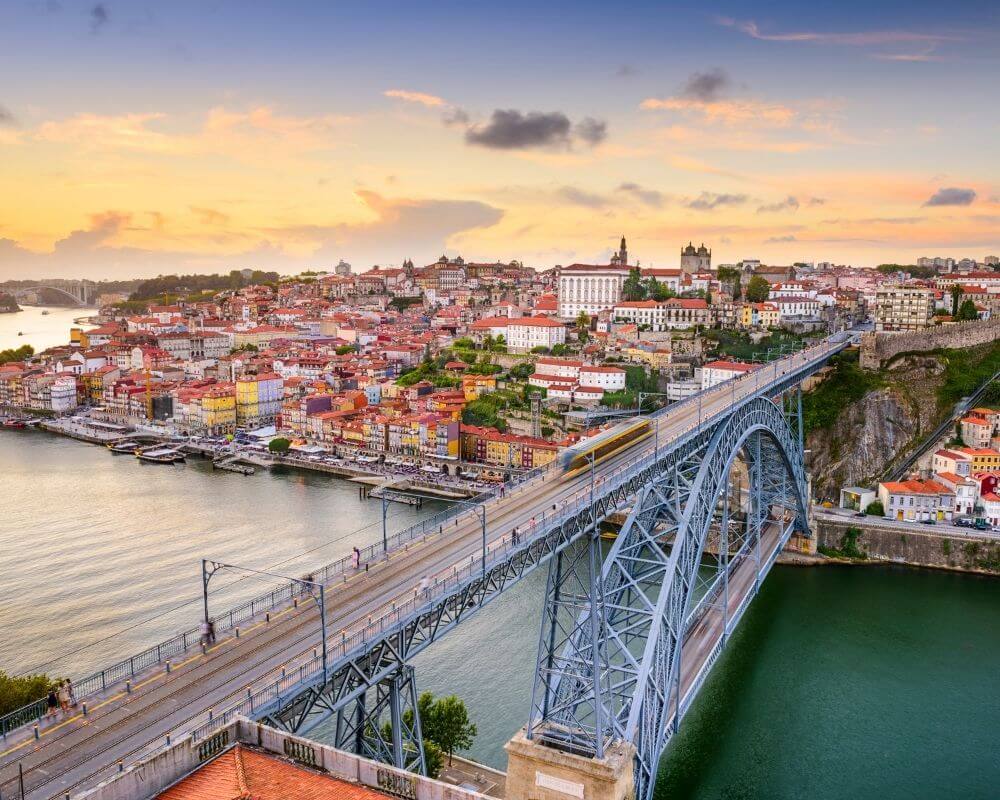
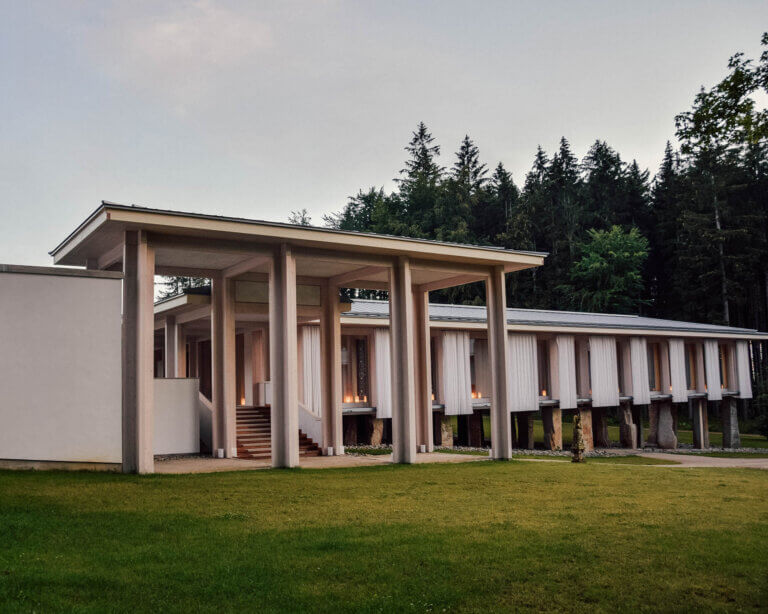
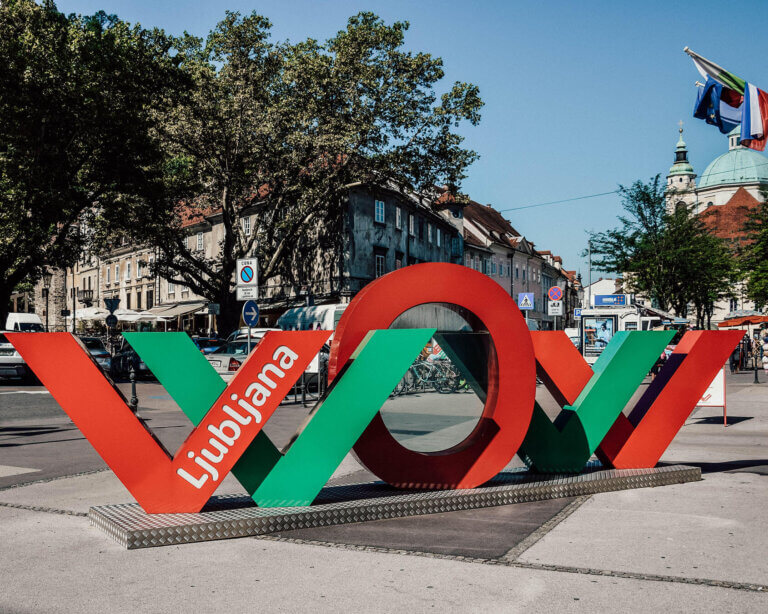
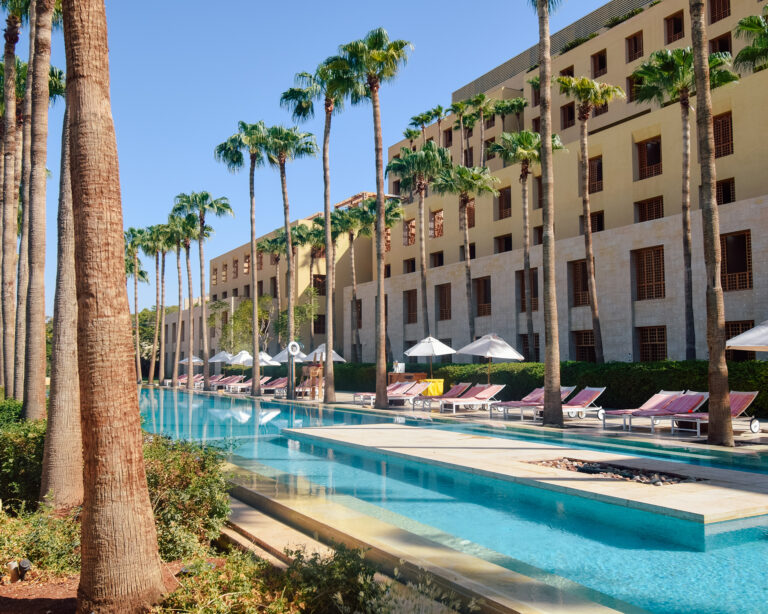


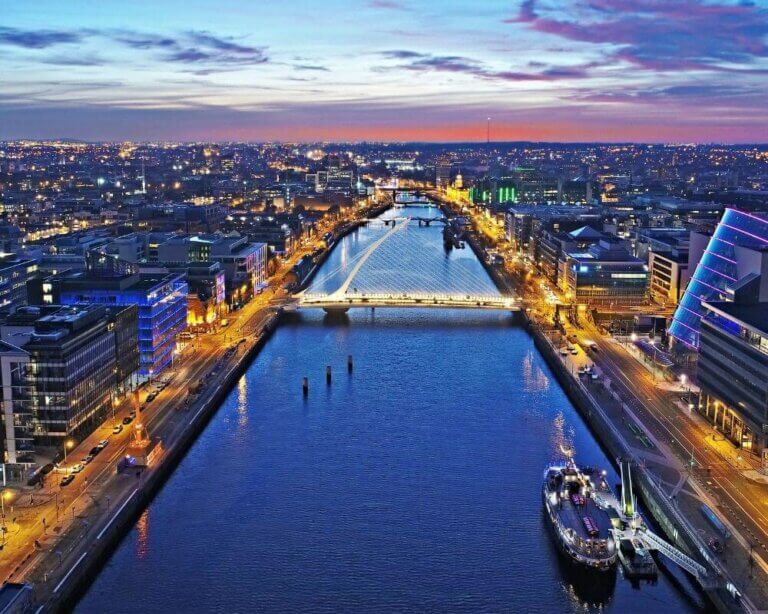
This is a fabulous guide to Lisbon. I highly recommend eating the custard pie tarts to keep up your energy when you climb Lisbon’s infamous hilly streets!
Hey Terri! I guess you meant Portugal as a whole right? 😉 And yes I absolutely agree with the custard pie! I ate so many when I was in Lisbon (before I went vegan) 🙂
Wow! So many amazing places to visit. Portugal is certainly on my list!
Oh yes it’s a wonderful country!
What a fantastic collab! Totally love the variety of recommendations…there is something for everyone on this list. I’d love to explore the caves and the beaches. Looks like the perfect summer holiday!
Thanks Mohana, very happy you like it! And yes the caves and beaches look so awesome 🙂
We went to Portugal in June of 2019 and fell in LOVE, we saw many of these spots but not all of them, so now I really want to go back. Your list is very comprehensive and will be a great resource when we plan a return trip b/c I will be going back. Great collab post–always fun to hear suggestions of many in one place!
Oh yes I feel you! I went there in 2018 and same happened to me. It’s such a wonderful country I’d love to visit again someday 🙂
Wow that’s a lovely list. I would love to visit these places in Portugal someday.saving it for my visit
I hope you’ll be able someday 🙂
I have not yet explored Portugal properly but am saving this so I can refer back when I do go: beautiful photos and so many things to see. I think I’ll be very spoilt for choice with your handy guide here.
Happy you find it useful!
Great post! I loved visiting Lisbon a few years ago, it’s one of my favourite European cities. Thanks for sharing so many lovely photos as well!
Oh yes I loved my time in Lisbon too 🙂
I haven’t made it to Portugal yet, so this guide will be really helpful when I plan a trip there later this year. There are so many beautiful places to visit!
It’s such a great country! I hope you can go there soon 🙂
Hi Lina, your post is awesome! It makes me want to explore Portugal even more. So far I´ve been only to Lisbon and loved it. Would love to explore the other parts of the country and some of the landmarks above, too. Thanks for putting them together.
Hey Pia, happy you like this post! Portugal is such a wonderful country to see 🙂
The Santa Justa lift looks so cool and I’ve never heard of it! I’ve wanted to visit Portgual for a while now and I’m definitely saving for later! so cool
It was a lot of fun to take a ride!
I am hoping to get back to Portugal in the next year. My first trip was so long ago and I didn’t see enough! Thanks for the great guide!
Same for me! Still so many places to visit 🙂
Best Places to visit in Portugal, thanks for sharing…